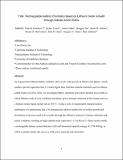| dc.contributor.author | Gallant, Betar M. (Betar Maurkah) | |
| dc.date.accessioned | 2020-09-30T16:14:23Z | |
| dc.date.available | 2020-09-30T16:14:23Z | |
| dc.date.issued | 2019-10 | |
| dc.identifier.issn | 1755-4349 | |
| dc.identifier.issn | 1755-4330 | |
| dc.identifier.uri | https://hdl.handle.net/1721.1/127777 | |
| dc.description.abstract | Next-generation lithium-battery cathodes often involve the growth of lithium-rich phases, which enable specific capacities that are 2−3 times higher than insertion cathode materials, such as lithium cobalt oxide. Here, we investigated battery chemistry previously deemed irreversible in which lithium oxide, a lithium-rich phase, grows through the reduction of the nitrate anion in a lithium nitrate-based molten salt at 150 °C. Using a suite of independent characterization techniques, we demonstrated that a Ni nanoparticle catalyst enables the reversible growth and dissolution of micrometre-sized lithium oxide crystals through the effective catalysis of nitrate reduction and nitrite oxidation, which results in high cathode areal capacities (~12 mAh cm–2). These results enable a rechargeable battery system that has a full-cell theoretical specific energy of 1,579 Wh kg–1, in which a molten nitrate salt serves as both an active material and the electrolyte. | en_US |
| dc.description.sponsorship | Vehicle Technologies Program (U.S.) (Award DE-18 FOA-0000991 (0991-1872)) | en_US |
| dc.language.iso | en | |
| dc.publisher | Springer Science and Business Media LLC | en_US |
| dc.relation.isversionof | 10.1038/S41557-019-0342-6 | en_US |
| dc.rights | Article is made available in accordance with the publisher's policy and may be subject to US copyright law. Please refer to the publisher's site for terms of use. | en_US |
| dc.source | Prof. Gallant via Elizabeth Soergel | en_US |
| dc.title | Rechargeable-battery chemistry based on lithium oxide growth through nitrate anion redox | en_US |
| dc.type | Article | en_US |
| dc.identifier.citation | Giordani, Vincent et al. “Rechargeable-battery chemistry based on lithium oxide growth through nitrate anion redox.” Nature Chemistry, 11, 12 (October 2019): 1133–1138 © 2019 The Author(s) | en_US |
| dc.contributor.department | Massachusetts Institute of Technology. Department of Mechanical Engineering | en_US |
| dc.relation.journal | Nature Chemistry | en_US |
| dc.eprint.version | Author's final manuscript | en_US |
| dc.type.uri | http://purl.org/eprint/type/JournalArticle | en_US |
| eprint.status | http://purl.org/eprint/status/PeerReviewed | en_US |
| dc.date.updated | 2020-09-30T13:45:38Z | |
| dspace.orderedauthors | Giordani, V; Tozier, D; Uddin, J; Tan, H; Gallant, BM; McCloskey, BD; Greer, JR; Chase, GV; Addison, D | en_US |
| dspace.date.submission | 2020-09-30T13:45:44Z | |
| mit.journal.volume | 11 | en_US |
| mit.journal.issue | 12 | en_US |
| mit.license | PUBLISHER_POLICY | |
| mit.metadata.status | Complete | |
